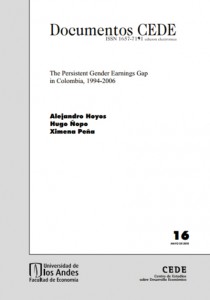The Persistent Gender Earnings Gap in Colombia, 1994-2006
| Year | : | 2010 |
|---|---|---|
| Author/s | : | Alejandro Hoyos, Hugo Ñopo, Ximeña Peña |
| Area/s | : | Employment, productivity and innovation, Ethnicity, gender and citizenship |
Alejandro Hoyos; Hugo Ñopo y Ximena Peña (2010). The Persistent Gender Earnings Gap in Colombia, 1994-2006. Universidad de los andes – Documentos CEDE 007094.
The authors surveys gender wage gaps in Colombia from 1994 to 2006, using matchingcomparisons to examine the extent to which individuals with similar human capitalcharacteristics earn different wages. Three sub-periods are considered: 1994-1998; 2000-2001; and 2002- 2006. The gaps dropped from the first to the second period but remained almost unchanged between the second and the third. The gender wage gap remains largely unexplained after controlling for different combinations of socio-demographics and job-related characteristics, reaching between 13 and 23 percent of average female wages. That gap is lower at the middle of the wage distributions than the extremes, possibly due to a gender-equalizing effect of the minimum wage. Moreover, the gap is more pronounced for low-productivity workers and those who need flexibility to participate in labor markets. This suggests that policy interventions in the form of labor market regulations may have little impact on reducing gender wage gaps.






